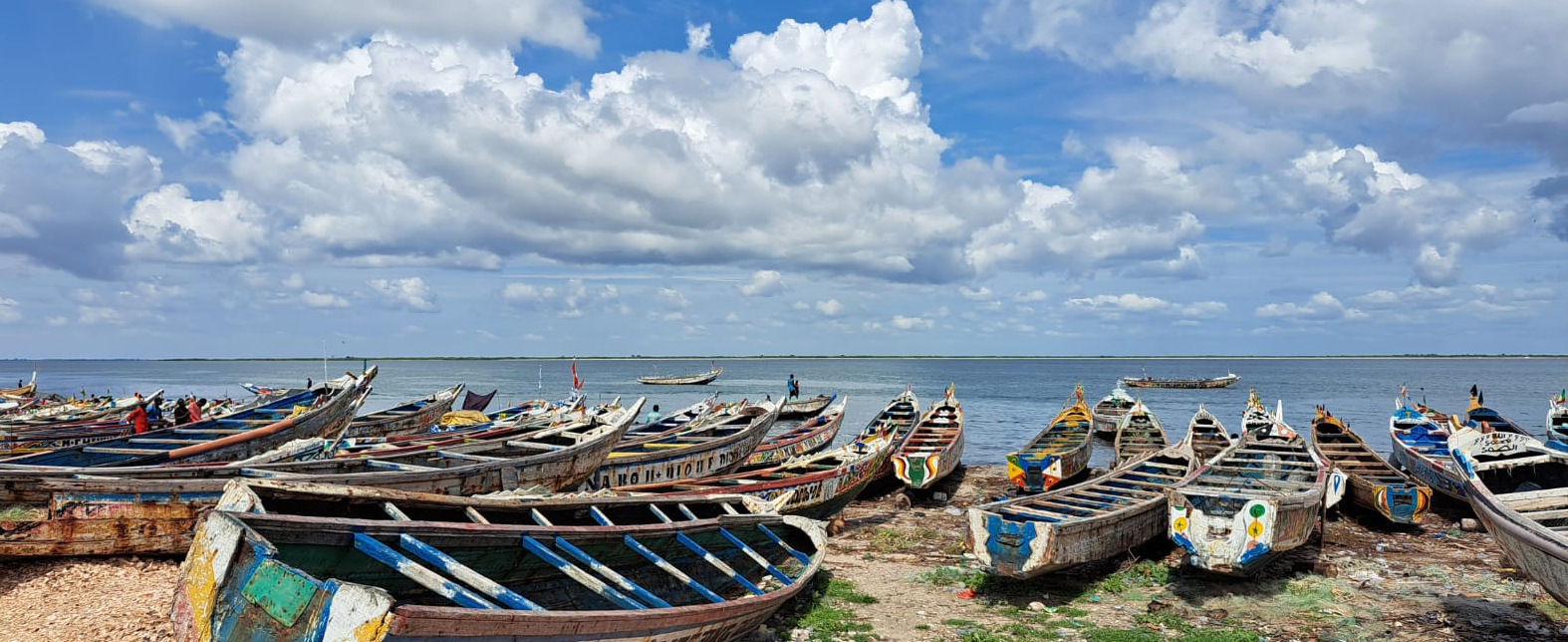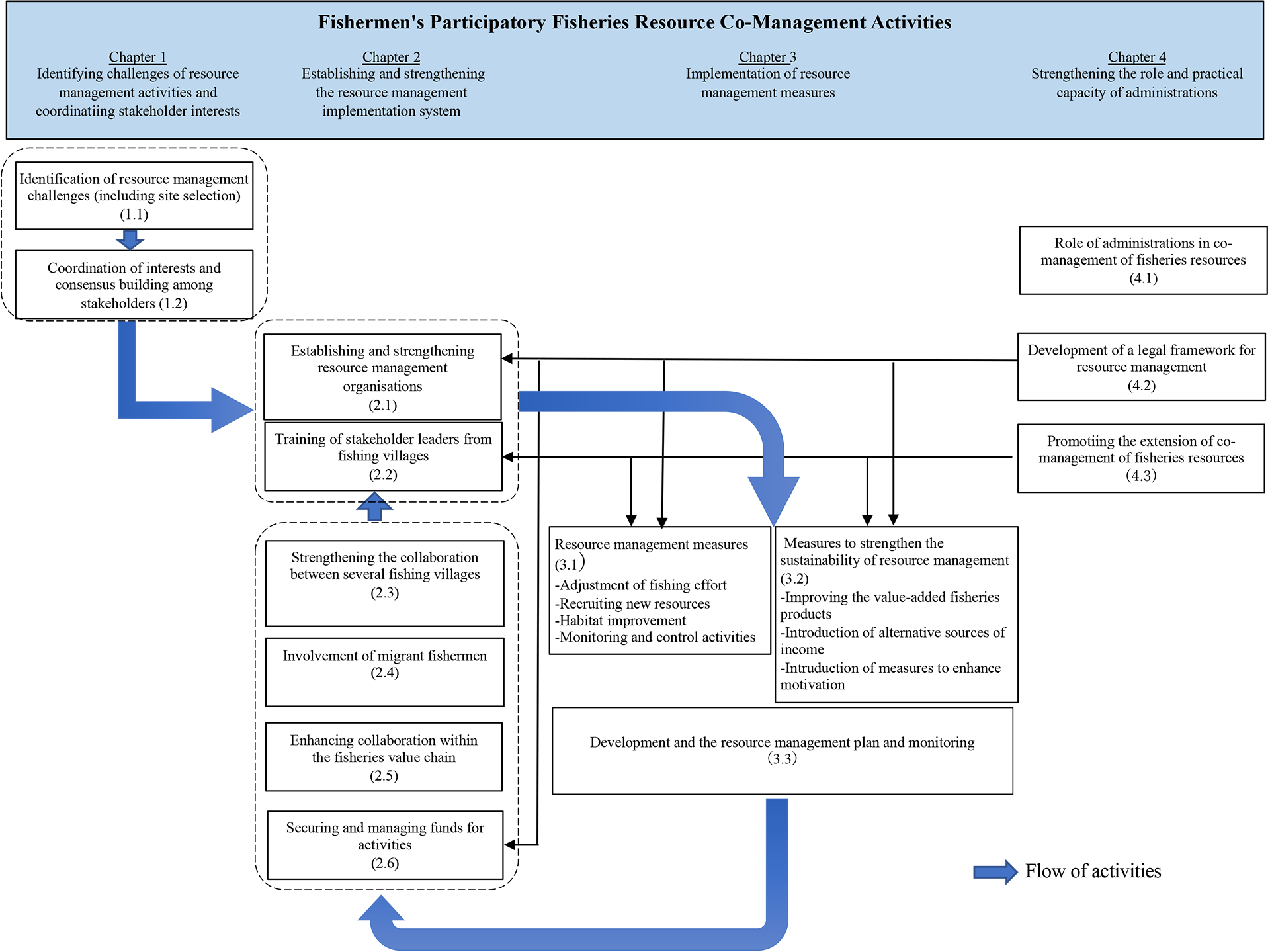Guidelines on Fisheries Resource Co-management

What Is Co-management of Fisheries Resources?
Co-management of fisheries resources refers to a method in which fishermen or people working in the field of fisheries (hereinafter referred to as resource users) and administration cooperate to manage fishery resources.
The recent decrease in fishery resources has been caused by an increase in the number of fishermen, the development of fishing techniques, proliferation of fishing companies, and deterioration of the habitat of the target species. This has resulted in a decrease in catch and fishermen's income, difficulty in supporting fishermen's families, a threat to food security, and a decrease in foreign exchange earnings. Fisheries administrations have introduced fishing regulations to reduce overfishing and rebuild resource stocks to address these challenges. However, as fishermen whose income are reduced by fishing regulations have little awareness of the need to comply with the regulations, administrative agencies have no choice but to intensify enforcement activities. It is often difficult for administrative agencies to crack down on the many artisanal fishery landing sites scattered along the coast owing to limited personnel and budgets.
Under these circumstances, the co-management of fishery resources, in which administrations actively support resource management activities that fishermen undertake on their own initiative, has been attracting attention. It enables fishermen and administrations to work together to achieve the sustainable use of fisheries resources. By clarifying current or potential problems, resource users recognise that such problems are their own issues and develop resource management measures (such as regulation of fishing efforts) to address them. Administrative agencies provide technical and legal support to resource users for recognising the problems they face and develop measures to solve them. In the co-management of fishery resources, resource users, including fishermen, are the main actors in resource management; therefore, there is no conflict between administrative agencies and resource users regarding monitoring and control. Both parties can work toward the same goal of sustainable resource use.
Target Audience and Purpose of These Guidelines
These guidelines are intended for practitioners responsible for fisheries resource management in West African countries. The intended audience for the term 'practitioners' of fisheries resource management are central government agencies and local government fisheries administrators. The objective of these guidelines is to help government organisations and local governments involved in fisheries resource management to play an appropriate role in collaboration with fishers and fisheries organisations to ensure the sustainable and effective use of fisheries resources.
In Senegal, the Japan International Cooperation Agency (JICA) launched support activities in the field of fisheries resource management in 2003. These activities have been successful in the application of the co-management approach to fisheries resources. At the West African Regional Fisheries Seminar1 held in 2013 under the leadership of the ‘Cogestion des Pêcheries Artisanales au Sénégal’ (COGEPAS), the following issues were discussed: (1) overfishing of artisanal fisheries in the West African region, (2) degradation of marine resources, (3) limitations of top-down resource management by the central government, and (4) achievements of the co-management of fisheries resources in Senegal. At the end of the seminar, the Dakar Declaration was adopted, which ‘recommends that each participating country in the Seminar adopt, trial, and disseminate the co-management approach to fisheries resources.
In the West African region, migratory resources that move across national boundaries are important targets for fishing, and groups of fishermen frequently follow this movement across national borders in search of highly-valued fisheries resources. Under these circumstances, when it comes to promoting the co-management of fisheries resources, resource management activities by a single country are often insufficient. Therefore, it is necessary to disseminate the co-management of fisheries resources in surrounding countries, rather than implementing it in one country. Based on the results of JICA's past support in the field of fisheries resources management in West African countries such as Senegal, these guidelines have been compiled to disseminate the joint management of fishery resources over the region.
To concretely explain the effort to implement co-management of fisheries resources, these guidelines present the essence extracted from efforts to address issues on resource management since the 2000s. In other words, the guidelines provide as many specific options as possible for starting resource management activities from scratch in one community and achieving sustainable activities in its surrounding areas.
In West African countries with different natural and social environments and at different stages of implementing resource management, the guidelines are presented to provide practitioners with practical tips for managing fisheries resources in their field activities.
Process of Co-management of Fisheries Resources
This involves selecting a fishing village community for resource management, identifying challenges related to resource management activities in a participatory manner, and sharing results with other stakeholders in the fishing village community and administration. Therefore, it is necessary to identify the stakeholders involved in relevant issues, understand interests among them, and promote interest coordination. At the same time, it is also important to build a resource management system by establishing an organisation responsible for implementing resource management activities to solve the issues and train leaders to become key members.
While developing such an environment, the resource management organisation, whose main members are resource users, will take the lead in formulating and implementing activities such as adjustment of fishing effort, nurture of new resources, and protection and restoration of the fishery habitat environment, which are direct methods of resource management, and will strengthen monitoring and enforcement activities. To enhance the sustainability of resource management, measures should be incorporated to increase the added value of marine products, introduce alternative sources of income, and strengthen the motivation of the actors involved.
The process of developing resource management measures will also consider strengthening cooperation with neighbouring fishing villages and linkages within the fisheries value chain as needed for activities, developing measures to involve migrant fishermen, and securing and properly managing financial resources for resource management organisations.
The path of activities for the co-management of fisheries resources is as follows. The administration will support community-led resource management activities, including the development of a legal framework for fishermen's rules. This includes the development of a legal framework for their rules, organisational management, and the creation of mechanisms to extend the co-management of fishery resources to other areas. To this end, the capacity of central and local government officials should be strengthened.
Structure and Usage of the Guidelines
This document includes guidelines for all the steps in implementing the aforementioned fishery co-management activities, starting from Chapter 1, identifying the challenges of resource management activities and coordinating stakeholder interests; Chapter 2, establishing and strengthening the resource management implementation system; Chapter 3, implementing resource management measures; and Chapter 4, strengthening the role and practical capacity of administrations (see Figure 1).
The sections in each chapter are modularised and can be used independently. Therefore, it is possible to extract and use only those sections that are relevant to the situation and issues in the country or region where the guidelines are to be used.

- Chapter 1
- ‘Identifying the challenges of resource management activities and coordinating stakeholder interests’, explains how to identify and share resource management challenges in the target village or locality, and how to coordinate interests to build stakeholder consensus on such challenges.
- Chapter 2
- ‘Establishing and strengthening the resource management implementation system’, describes how to strengthen the organisations responsible for resource management activities and create new organisations to run them if necessary, how to build the capacity of leaders to run resource management organisations, how to strengthen links between fishing villages and fisheries stakeholders to make resource management activities more effective, how to involve migrant fishers in the local resource management activities, and how to obtain and manage the financial resources needed to run the organisations.
- Chapter 3
- ‘Implementation of resource management measures’, provides principles on the choice of resource management measures, a wide range of resource management measures, tips for implementing these measures, and examples of past practices. This chapter also describes measures to enhance the sustainability of resource management measures, such as the introduction of value-added fishery products, alternative sources of income, and motivational measures, which are sometimes introduced in combination with resource management measures. It also explains how individual resource management and sustainability enhancement measures are integrated to suit the situation and needs of the field, and how to develop and implement comprehensive resource management plans.
- Chapter 4
- ‘Strengthening the role and practical capacity of administrations’, explains the role of administrations in the co-management of fisheries resources, which differs from top-down management, and the development of a legal framework that provides a basis for resource management regulations and monitoring and control activities implemented by resource management organisations. It describes the process of creating a mechanism for the administration to disseminate successful cases of the co-management of fisheries resources in the surrounding areas with experienced fishermen leaders.
Three columns were inserted in the main text to help readers understand the activities in each chapter in a more practical manner: ‘Learning from real-life experiences’, ‘Tips for practice’, and ‘Useful knowledge’.
‘Learning from real-life experiences’ provides examples from the past, both in Senegal and surrounding countries, related to the activities described in the guidelines. ‘Tips for practice’ is intended to give readers a concrete idea of how to implement the activities concerned. ‘Useful knowledge’ provides background and facts that may be useful for implementing the activities described in the guidelines. More information on any of these boxes can be obtained from the case studies that have been prepared as a reference for the guidelines. Each part of the case studies that is relevant to any item in the column is indicated by the case number in the column box.
By using the guidelines together with the case studies and tools, we hope that the activities of the fisheries administration, local government officials, and fisheries stakeholder leaders, including fishers, as well as community leaders, will be clarified, and that each country and region will create their own unique methods for the co-management of fisheries resources and develop their own management methods for fisheries resources that suit their circumstances and challenges.